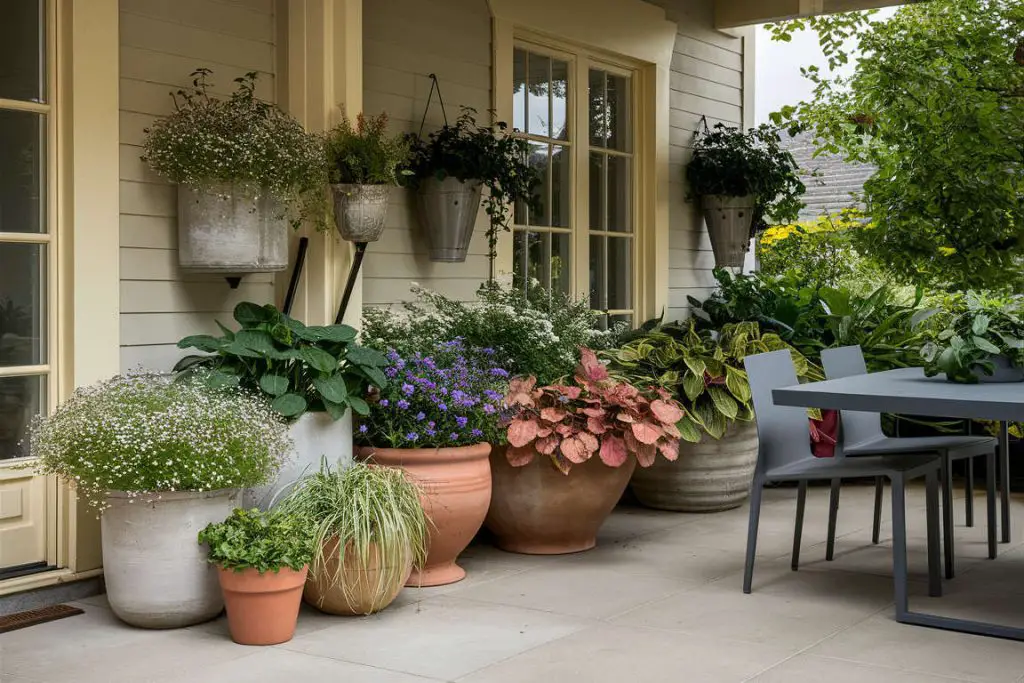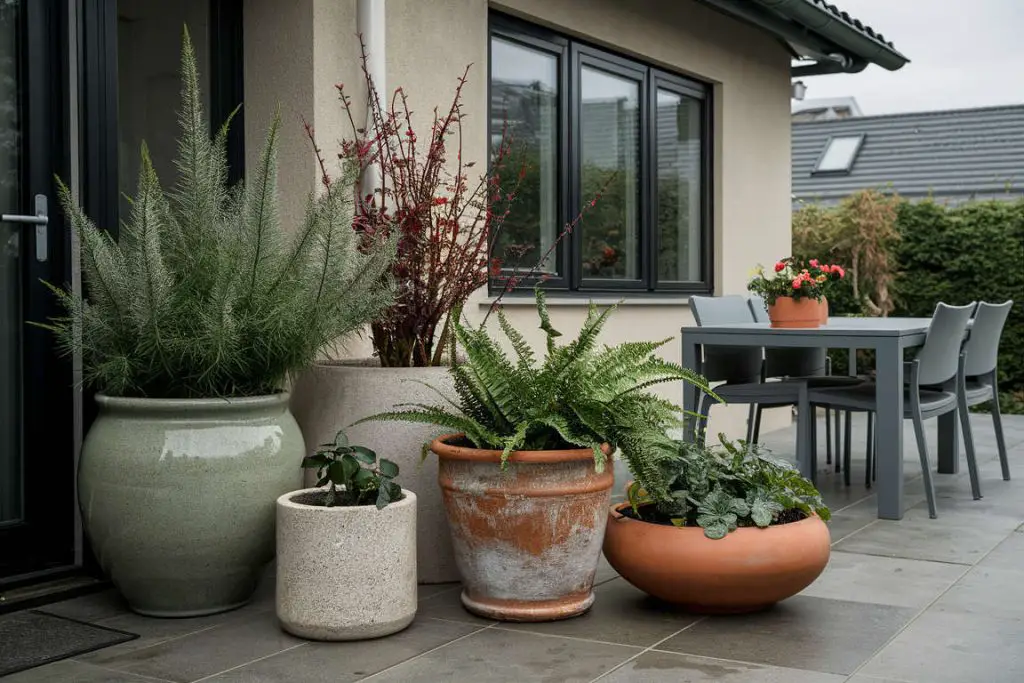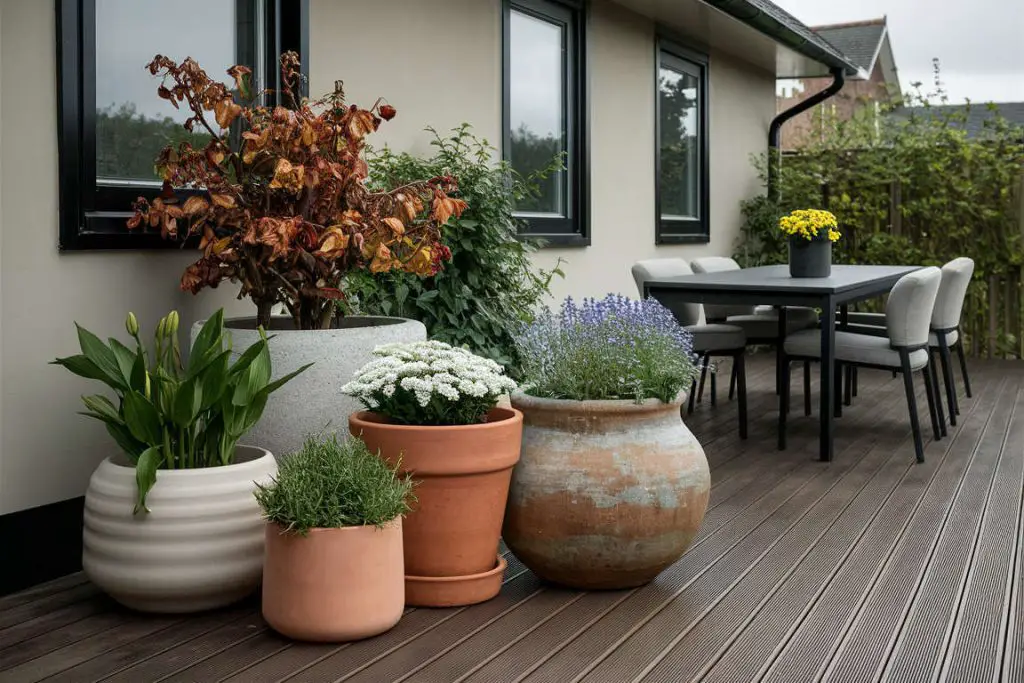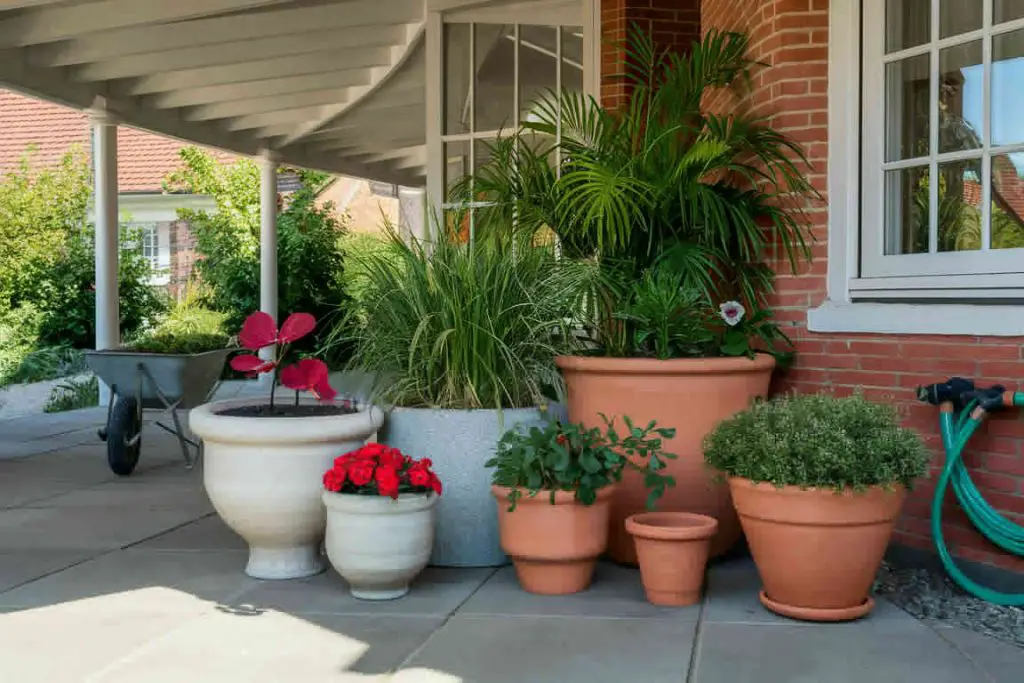Elegant Shade: Creating Stunning Potted Plant Arrangements for Shaded Gardens
Shade-tolerant perennials can transform any shaded garden area into a lush and vibrant retreat. These plants not only thrive in low-light conditions but also offer a stunning variety of textures, colors, and heights. With the right combination of plants and thoughtfully chosen pots, shaded patios and decking can become captivating focal points.
Below we present five exceptional potted plant arrangements, each designed to flourish in shaded environments, providing both beauty and interest throughout the seasons. Discover how to elevate your shaded garden spaces with these elegant, shade-loving perennials.
Combining Hostas, Forget-Me-Nots, Heucher, Sweet Woodruff

Creating a beautiful outdoor potted plant arrangement can transform any decking or patio into a vibrant and inviting space. Combining various plants with different textures, colors, and heights adds depth and interest to your garden. The combination of Hostas, Forget-Me-Nots, Heuchera, and Sweet Woodruff provides a delightful mix that thrives in partial shade, making it ideal for many outdoor settings.
Hostas are a fantastic choice for their lush, broad leaves that come in various shades of green, often with striking variegation. They thrive in shaded areas and bring a sense of fullness to the arrangement. A large ceramic pot in earth tones or muted greens complements their foliage, enhancing the natural look while providing a sturdy base.
Forget-Me-Nots (Myosotis) add a splash of delicate blue flowers, creating a soft, romantic touch. These plants work well as fillers, bringing color and lightness. Small to medium-sized terracotta pots suit Forget-Me-Nots perfectly, as the natural clay material keeps the soil cool and maintains moisture levels, essential for these charming flowers.
Heuchera (Coral Bells) offer striking foliage in shades of reddish-orange, adding a bold contrast to the green of Hostas and the blue of Forget-Me-Nots. Heuchera’s compact size and vibrant leaves make them an excellent choice for adding visual interest. A medium-sized concrete pot works well here, as its neutral color enhances the vivid hues without overwhelming the arrangement.
Sweet Woodruff (Galium odoratum), with its low-growing habit and small white flowers, serves as an excellent ground cover for pots, providing a delicate backdrop that highlights the other plants. Plant Sweet Woodruff in shallow, wide containers made of lightweight materials like fiberglass or resin. These materials make it easy to move the pots around your patio or deck to find the perfect spot.
This combination of Hostas, Forget-Me-Nots, Heuchera, and Sweet Woodruff ensures a varied and visually appealing arrangement suitable for any shaded patio or deck. Using different types of pots not only enhances the aesthetic but also caters to the specific needs of each plant, ensuring a thriving and harmonious display.
Arranging a variety of plants in decorative pots can create a captivating focal point on your decking or patio. Selecting plants like Astilbe, Hellebore, Japanese Painted Fern, and Lungwort ensures a mix of textures, colors, and heights that thrive in shaded areas, providing a serene and elegant display.
Arrangement of Astilbe, Hellebore, Japanese Painted Fern, Lungwort

Arranging a variety of plants in decorative pots can create a captivating focal point but if you have shaded areas you need to be careful with your choice. Selecting plants like Astilbe, Hellebore, Japanese Painted Fern, and Lungwort ensures a mix of textures, colors, and heights that thrive in shaded areas, providing a serene and elegant display.
Astilbe offers feathery plumes of flowers that come in shades of pink, white, and red. These plants add vertical interest and a soft, airy texture to the arrangement. A large glazed ceramic pot in neutral tones can enhance their delicate blooms while ensuring stability and adequate drainage.
Hellebore (Lenten Rose) features nodding flowers in various hues, including white, pink, and deep purple. Known for their early blooming period, Hellebores bring color to the garden when few other plants are flowering. Medium-sized stone or concrete pots complement the sturdy nature of these plants, providing a solid base and a timeless aesthetic.
Japanese Painted Fern adds a unique touch with its finely divided fronds that display a striking blend of green, silver, and burgundy. This fern’s intricate foliage brings texture and a hint of drama to the arrangement. Placing these ferns in medium-sized, weathered terracotta pots can highlight their subtle beauty and maintain a rustic charm.
Lungwort (Pulmonaria) presents a charming combination of spotted leaves and clusters of small, tubular flowers in shades of blue and pink. Lungwort serves as an excellent ground cover, adding both color and interesting foliage to the mix. A wide, shallow pot made of lightweight resin or fiberglass works well, allowing easy movement and flexibility in arranging the display.
Combining Astilbe, Hellebore, Japanese Painted Fern, and Lungwort creates a visually rich and texturally varied arrangement suitable for shaded patios or decking. The selection of different pot materials not only enhances the visual appeal but also meets the specific needs of each plant, ensuring a thriving and harmonious display.
A Shade Full of Toad Lily, Coral Bells, Foamflower, Siberian Bugloss

Designing a container garden for shaded or partially shaded areas can bring a delightful mix of colors and textures with the right combinations. Choosing plants like Toad Lily, Coral Bells, Foamflower, and Siberian Bugloss ensures a dynamic and captivating display that thrives in shaded environments.
Toad Lily (Tricyrtis) features exotic-looking, spotted flowers that bloom in late summer to fall. These unique flowers add an element of surprise and elegance to the arrangement. Medium-sized ceramic pots with a glossy finish can accentuate their intricate patterns and provide a stable home for their growth.
Coral Bells (Heuchera) bring vibrant foliage in shades of red, purple, and green, adding a bold splash of color. Known for their striking leaves, Coral Bells enhance the visual interest of any arrangement. Large stone or concrete pots offer a solid base and complement the plant’s rich hues, providing a timeless and sturdy look.
Foamflower (Tiarella) offers delicate, frothy white or pink flowers that rise above attractive, lobed leaves. These plants add a light and airy feel to the arrangement. Small to medium-sized terracotta pots suit Foamflowers well, as the porous material helps maintain ideal moisture levels and provides a classic garden aesthetic.
Siberian Bugloss (Brunnera macrophylla) features heart-shaped leaves often marked with silver, along with clusters of small, forget-me-not-like blue flowers. This plant adds both texture and a touch of whimsy to the display. A medium-sized, weathered clay pot highlights its foliage and flowers, creating a harmonious and natural look.
Arranging Toad Lily, Coral Bells, Foamflower, and Siberian Bugloss results in a rich, textured arrangement perfect for shaded patios or decks. Using different types of pots not only enhances the visual appeal but also caters to the specific needs of each plant, ensuring a thriving and harmonious display.
A Beautiful Aesthetic Mix: Bleeding Heart, Japanese Forest Grass, Anemone, Solomon’s Seal

When imagining a shade-loving container garden for your decking or patio can add charm and elegance to your outdoor space. Incorporating plants like Bleeding Heart, Japanese Forest Grass, Anemone, and Solomon’s Seal ensures a stunning mix of textures, colors, and forms that thrive in low-light conditions.
Bleeding Heart (Dicentra spectabilis) showcases arching stems with heart-shaped, pink or white flowers that dangle gracefully. These delicate blooms add a touch of romance to the arrangement. Large ceramic pots in soft, pastel shades enhance their gentle beauty and provide a stable base for their growth.
Japanese Forest Grass (Hakonechloa macra) offers flowing, grassy foliage in shades of green or variegated yellow and green. This ornamental grass brings movement and texture to the display. Medium-sized, lightweight fiberglass pots work well, allowing for easy repositioning and providing a modern, sleek look that complements the plant’s elegance.
Anemone (Anemone x hybrida) produces cheerful, daisy-like flowers in shades of pink, white, and purple, blooming in late summer to fall. These vibrant flowers add a splash of color and height to the arrangement. Stone or concrete pots provide a sturdy foundation and a timeless aesthetic that pairs beautifully with Anemones.
Solomon’s Seal (Polygonatum) features graceful, arching stems with small, bell-shaped white flowers and lush green foliage. This plant adds an element of elegance and structure to the container garden. A medium-sized terracotta pot is ideal, as its natural, earthy look enhances the classic beauty of Solomon’s Seal.
The combination of Bleeding Heart, Japanese Forest Grass, Anemone, and Solomon’s Seal creates a visually engaging and harmonious arrangement suited for shaded patios or decks. Using a variety of pots not only elevates the aesthetic appeal but also meets the individual needs of each plant, ensuring a vibrant and flourishing display.
Displaying Foxglove, Hosta, Jacob’s Ladder, Lamium Together

Designing an eye-catching container garden for your decking or patio can bring life and color to shaded areas. Choosing plants like Foxglove, Hosta, Jacob’s Ladder, and Lamium creates a beautiful, diverse display that thrives in partial shade.
Foxglove (Digitalis) presents tall spikes of tubular flowers in shades of pink, white, and purple. These towering blooms add height and a dramatic flair to the arrangement. Large glazed ceramic pots in deep, rich colors enhance their stately presence and provide a sturdy base for these tall plants.
Hosta features broad, lush leaves in various shades of green, often with striking variegation. These plants contribute a sense of fullness and texture to the garden. Medium-sized stone or concrete pots work well, offering a solid foundation and complementing the greenery with their neutral tones.
Jacob’s Ladder (Polemonium caeruleum) brings delicate, fern-like foliage and clusters of blue or white flowers. These charming blooms add softness and an airy feel to the mix. Small to medium-sized terracotta pots suit Jacob’s Ladder perfectly, as the natural clay material helps maintain optimal moisture levels.
Lamium (Dead Nettle) offers attractive, variegated foliage and small, colorful flowers. This plant serves as an excellent ground cover, adding both texture and color. A wide, shallow pot made of lightweight resin or fiberglass provides flexibility in arranging and moving the display while ensuring adequate space for the spreading habit of Lamium.
Putting together Foxglove, Hosta, Jacob’s Ladder, and Lamium results in a diverse and visually appealing container garden suitable for shaded patios or decking. Selecting different types of pots not only enhances the aesthetic but also caters to the specific needs of each plant, ensuring a thriving and harmonious display.
Final Thoughts
Transforming shaded garden areas into beautiful, serene retreats is both rewarding and enjoyable. The five potted plant combinations outlined in this guide offer a variety of textures, colors, and heights that will thrive in low-light conditions.
Selecting the right shade-loving perennials for your USDA Hardiness Zone is crucial to ensuring their success and longevity. Each arrangement has been carefully designed to provide visual interest and seasonal beauty. Embrace the potential of your shaded spaces and enjoy the lush, vibrant displays these shade-tolerant perennials can bring to your garden.
